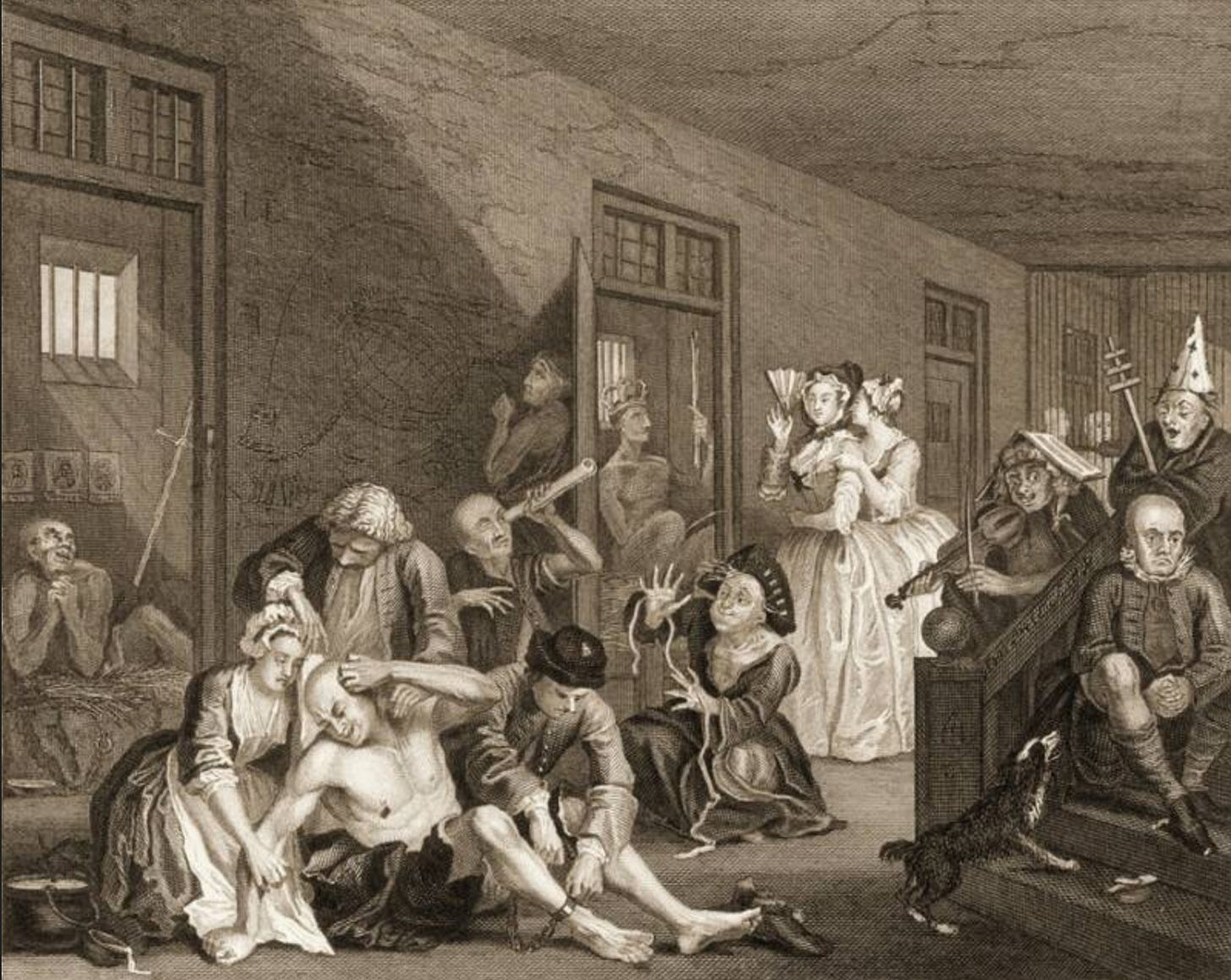Depending on where you learned your history, King George III of England, brilliantly satirized in Hamilton, who reigned from 1760 to 1820, is either known as the tyrant George, whose unpopular tax on tea led to the Boston Tea Party, and ultimately the loss of the Thirteen Colonies altogether — or else as the beloved monarch who created the United Kingdom and the Union Jack, abolished slavery, sent Captain Cook off around the world, and whose army defeated Napoleon at the battle of Waterloo. He founded the National Library, supported the Royal Academy of Arts, and donated half his income to charity. As the first Hanoverian monarch born in England, he embraced his country and mother tongue with fervent patriotism, and was equally loyal to his beloved Queen Charlotte, with whom he had fifteen children.(1)
He is, however, probably best known for having gone insane halfway through his reign, leaving the country in the hands of a Regent, his son the Prince of Wales - which by the way, is where the Regency period of Jane Austen and Bridgerton gets its name.
Always an energetic sort of chap interested in everything from astronomy to agriculture, he often exhausted his wife and children with his endless flights of fancy. His tireless enthusiasm for life took a more troubling turn in late 1788 when he began to demonstrate erratic behaviour, incoherent speech, insomnia and even inappropriate sexual behaviour. According to a journal kept by his equerry Robert Grevell, the king “talked for nineteen hours straight”, “foamed at the mouth” and was “entirely deranged.”(2)
His doctors were mystified, and tried every form of treatment available to them at the time, things we consider barbaric and utterly useless today; they bled him, burned his skin with arsenic and antimony poultices to draw out evil humours, starved him, made him vomit, gave him diarrhea and plunged him into freezing water, and finally applied leeches to his temples to literally suck the madness out his brain.(3)
When these efforts failed, Queen Charlotte called for the services of clergyman physician Dr. Francis Willis, who had become famous for his private hospital in the north of England where “wrongheads” were treated, usually with little more than physical restraint and a punitive carrot-and-stick approach to meals. If the King behaved, he was allowed to eat a hearty meal with utensils; if he raved and ranted, he was served an unappealing mash that he had to eat with his fingers. Not surprisingly, he tended to behave more often than not. (4)
It was, perhaps, the birth of psychiatry as a recognized medical specialty, even if the primitive methods employed showed little understanding of psychology. Dr. Willis believed that restraining patients in soft cotton strait jackets and letting them calm themselves into a sedate, if not entirely rational, state was the solution to their bouts of madness. It has to be said that, as disturbing as this treatment seems, it was far gentler and far more respectful of the patient than what the mentally ill suffered at asylums like the Bethlem Royal Hospital,(5) whose name, when pronounced ‘bedlam’ made its way into our language as a synonym of chaos and turmoil. Patients at Bedlam were chained to the wall and ignored, for the most part, except when wealthy aristocrats would tour the facility to gape at the antics and anguishes of the mad.
The King did improve under Willis’ care, although it’s unlikely the doctor’s harsh methods had much to do with it. By 1789, the King was back to his normal self, much to the relief of the government and the people in general. It would not last. He had two more relapses, in 1801 and 1804, and in 1810, a devastating breakdown left him permanently insane. By his last decade he was blind from cataracts, and would roam the halls of Windsor Castle, a pathetic, almost unearthly figure in dirty bed clothes and a flowing grey beard. When his beloved wife died in 1818, he couldn’t mourn her, because he had no idea who she was.
The Prince of Wales, became Regent in 1811, and lived a dissolute, idle life of excessive leisure, gambling, drinking and womanizing, finally becoming King George IV in 1820, when George III died, aged 81, having reigned for sixty years. (6)
Precisely why the King went insane — if he did—has been the subject of much debate over the last two hundred years. At the time, madness was seen as a family disgrace, and accordingly, none of the King’s doctors were willing to ascribe his illness to lunacy. This desire to protect the Royal Family’s reputation emerged again in the 20th century — but more on that later.
Some historians believe the King’s 1788 breakdown was triggered by difficult dealings with his eldest son, the profligate, womanizing Prince George - the one child among fifteen that he did not utterly adore. Others point to an episode in 1765 where the King retired from public life for several months and which prompted Parliament to pass an act providing for a Regent in case of the King’s incapacitation or death while his heirs were still minors.
Some scholars believe that it was the 1783 deaths of two of the King’s youngest sons, Octavius aged four, and Alfred, only two, within six months of each other that caused the King to become incurably mentally ill. Even five years later he was observed, one cold Christmas Eve, cradling a pillow and calling it Octavius, his dead son. And when his favourite daughter, Princess Amelia, died of tuberculosis in 1810, the King broke down completely. According to Dr. Willis, the king would “cry in a wild, monotonous, delirious way “Oh Emily (his nickname for her) why won’t you save your father? I hate all physicians…” He often hallucinated that he was speaking with her, assuring himself that she was healthy and well, with a family of her own, that she ‘would never grow older and would always be well.’ (7)
In the 1960’s, a mother-and-son team of psychiatrists attempted to explain George’s illness as the result of genetic disease. Doctors Ida McAlpine and Richard Hunter combed through the records relating to George’s illness and declared that he had suffered from acute porphyria, a condition resulting from the buildup of porphyrins, proteins that are precursors of heme, which itself is a precursor of the oxygen-carrying haemoglobin in our red blood cells. Porphyrins are cytotoxic in large amounts, and cause severe symptoms such as abdominal pain, nausea, vomiting and occasionally, psychiatric symptoms such as insomnia, mania, and even psychosis. As an aside, a particular variety of porphyria affects the skin and causes an aversion to sunlight, and since Vlad the Impaler was suspected of having the disease, this may have led to the idea that vampires are allergic to sunlight.
McAlpine and Hunter’s papers(8,9) in the British Medical Journal were immediately disputed by both psychiatrists and physicians familiar with porphyria, and yet, astonishingly, their theory gained wide acceptance, especially after the publication of their best-selling book George III and the mad-business.(10) The 1991 Alan Bennet play The Madness of King George was adapted for the screen as the 1994 movie of the same name, a notation at the end of which categorically states that George had porphyria.
It’s unclear why so many eminent publications, physicians and historians fervently defended the porphyria diagnosis, in spite of the selective nature of McAlpine’s and Hunter’s research and their misleading interpretation, which, according to Timothy Peters, author of King George III, bipolar disorder, porphyria and lessons for historians (11), bordered on the fraudulent. McAlpine and Hunter “apparently did not consider the mental state of the King during…major episodes”, Peters states, but insisted instead that discoloured urine provided the final proof of diagnosis. Porphyria sufferers’s urine will turn a dark purple colour if left for several days in the sunlight, and it was this symptom that McAlpine and Hunter chose to focus on, even though George’s medical records only reveal one incident of a bluish tinge to his urine after taking a new medication, and six previous weeks of normal coloured urine.
It has been suggested that McAlpine and Hunter’s motive for falsely ascribing the king’s illness to a metabolic disease was to ‘remove the taint of mental illness from the house of Windsor, for which they hoped to be appropriately rewarded.’ As I mentioned at the beginning, mental illness was a family disgrace in the 19th century, and seemingly McAlpine and Hunter believed it still was even in the middle of the 20th.
So what is the current diagnosis for George’s recurring bouts of insanity? Most medical historians and physicians now believe he suffered from bipolar disorder(12), formerly known as manic depression, particularly mania and possibly episodes of hypomania. Mania presents with racing thoughts, rambling speech, mood changes, a decreased need for sleep and often uninhibited social or sexual behaviour, all of which the King demonstrated during his four bouts of the disorder. Hypomania appears similar, but the duration of these episodes is counted in days, rather than the weeks or months that mania lasts.
Historians studying George’s own papers have discovered an interesting linguistic clue to his disorder. At St George’s, University of London Dr. Peter Garrard and Dr. Vassiliki Rentoumi(13) discovered that When suffering from an episode of mania, George would write much longer sentences than he would when he was well. It’s not uncommon to find sentences of 400 words, with eight verbs, and much more colourful, vivid language than he typically used. This is seen in patients with bipolar disorder today.
In fact, George exhibited so many known signs of mania and hypomania, such as euphoria and dysphoria, irritability and increased psychomotor activity, hallucinations and delusions, that it’s hard not to accept the hypothesis that bi-polar disorder plagued the king, and not porphyria or arsenic and antimony poisoning, as some others have suggested — ironically enough, from poultices given to cure his madness.
And yet, the diagnosis of porphyria stubbornly remains. Perhaps the continuing stigma of mental illness is at work, making researchers subconsciously more willing to accept a biological reason for his symptoms. Perhaps McAlpine and Hunter genuinely believed they had found the correct diagnosis, and were loathe to discard it. It’s still a wide-open area of study for historians and medical researchers.
Even though a definitive diagnosis won’t be able to help the once gentle, benevolent King George, it might help further de-stigmatize mental illnesses, and help us gain a better insight into those who suffer from them.
Works Cited
Works cited should go here (this page is optional). See the Works Cited Format document for information on formatting citations.
1. https://en.wikipedia.org/wiki/George_III
2. https://www.rct.uk/collection/1047014/journal-of-his-majestys-most-serious-and-afflicting-illness
3. https://en.wikipedia.org/wiki/George_III
4. https://en.wikipedia.org/wiki/Francis_Willis_(physician)
5. https://en.wikipedia.org/wiki/Bethlem_Royal_Hospital
6. https://en.wikipedia.org/wiki/George_IV
7. https://thecrownchronicles.co.uk/history/history-posts/george-iii-and-his-madness/
8. Macalpine I, Hunter R. The ‘insanity’ of King George III: a classic case of porphyria. BMJ 1966;1:65–71
9. Macalpine I, Hunter R, Rimington C. Porphyria in the Royal Houses of Stuart, Hanover and Prussia. A follow-up study of George III's illness. BMJ 1968;1:7–18 10.1136/
bmj.1.5583.7
10.Macalpine I, Hunter R. George III and the mad-business. London: Allen Lane, 1969 10.1136/bmj.1.5479.65
11. (Peters T. King George III, bipolar disorder, porphyria and lessons for historians. Clin Med (Lond). 2011 Jun;11(3):261-4. doi: 10.7861/clinmedicine.11-3-261. PMID: 21902081; PMCID: PMC4953321
12. https://en.wikipedia.org/wiki/Bipolar_disorder
13. https://www.bbc.com/news/magazine-22122407











Share this post